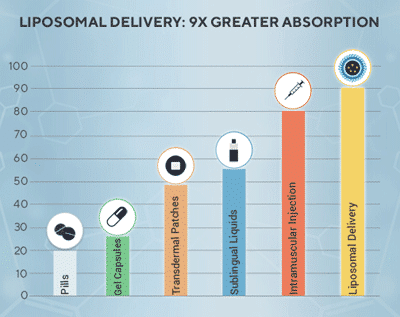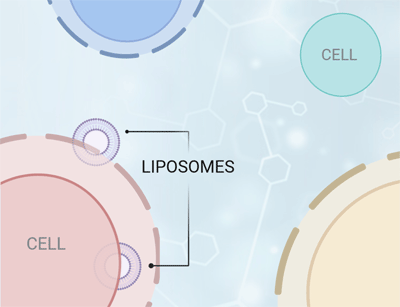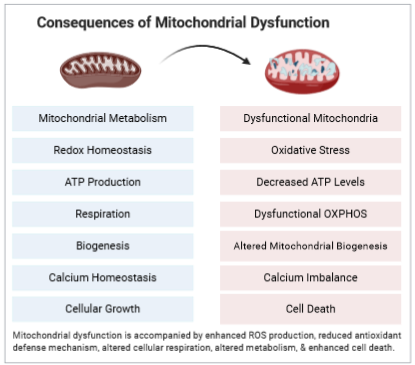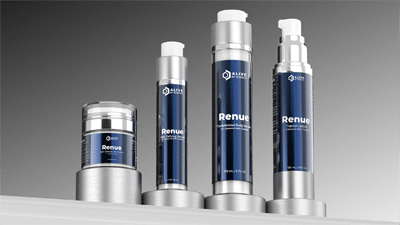Liposomes
Liposomes are an advanced delivery vehicle, protecting a much higher percentage of active ingredients from digestion, while slowly releasing the payload into the bloodstream.
- liposomes improve permeation of products to the site where applied, for localized treatment (in the skin)
- liposomes also offer systemic nutrient delivery (in the body)
- liposomal topicals and transdermals can optimize cellular uptake and effectiveness
What Liposomes Are Made Of
A Liposome is made up of a spherical vesicle with the inner contents containing the active ingredients, which are protected by an outer layer comprised of tiny fat-like particles, called the Phospholipid Layer. Liposomes have the ability to carry ingredients that are hydrophobic ("water-fearing") and hydrophilic ("water-loving"). (Source)

Advantages to Transdermal Liposomal Delivery
- superior stability of active ingredients
- higher absorption and greater efficacy
- may circumvent first-pass metabolism - meaning, more of the nutrients will reach your bloodstream
- enhanced skin permeability, allowing more actives past the outer layer & deeper into the cells
- the dose is slowly released so the supplement's concentration level can stay fairly constant in the body
Safety of Liposomal Delivery
Liposomes closely resemble the structure of cell membranes, and as a result the
"Liposomes are valued for their biological and technological advantages, and are considered to be the most successful drug-carrier systems known to date." - International Journal of Nanomedicine, Liposomes As Nanomedical Devices
How Are they Absorbed?

The inclusion of lipid vesicles into lotions can enhance their stability, prolong active product release, enhance transdermal permeability, and increase localization of the active within the skin. - Hydrogels and Their Combination with Liposomes, Niosomes, or Transfersomes for Dermal and Transdermal Drug Delivery
Advantages of Transdermal NAD+ on Aging Skin
Accelerated Skin Aging
Accelerated skin aging is common, and it's important to understand some of the causes, in order to address them. Daily exposure to solar radiation contributes to cellular dysfunction within the skin. This results in accelerated skin aging (photoaging), and disturbances to the normal hormeostatic state of the skin. *Homeostasis: This is the condition of optimal functioning within your skin.Skin's Appearance & Evidence of Damage
Evidence of damage may appear in numerous ways. Chronological aging is characterized by thinning of the skin, which appears as dryness and wrinkles. UV-damaged skin has a thicker, leathery-like appearance with deeper wrinkles and pigmentation issues. (Source) Cellular NAD+ pools are lower in aged skin. Mitochondria are one of the primary targets of damage from chronological and UV-induced skin aging. (Source, Source)"Several studies have directly or indirectly linked mitochondrial dysfunction to both chronological and photo-aging of the skin." - Mitochondria in Skin Health, Aging, and Disease, Cell Death & Disease
Mitochondrial Dysfunction & Depletion of NAD+
An increase in oxidative stress contributes to the depletion of NAD+ and ATP (a molecule that carries energy within a cell). The damage contributes to mitochondrial dysfunction in both the short-term & long-term, creating a
NAD+ Regulates Mitochondrial Maintenance
Mitochondrial maintenance through mitophagy (selectively eliminating the defective mitochondria) and mitochondrial biogenesis (synthesis and production of new mitochondria) is vital to cellular homeostasis and health. (Source) NAD+ regulates mitochrondrial maintenance. In this study, when levels of NAD+ in old mice were raised, their mitochondrial function was restored to that of young mice. (Source)"NAD+ and its primary precursor nicotinamide have been known for some time to impact skin homeostasis based on linkages to dietary requirements, treatment of various inflammatory conditions, photoaging..." - The evolving role of the NAD+/nicotinamide metabolome in skin homeostasis, cellular bioenergetics, and aging
Increasing NAD+ Levels in the Skin
Delivery of NAD+ through transdermal liposomal serums and lotions, is an optimal way to safely raise levels of NAD+ in the skin. In dermal fibroblasts (cells within the dermis), nicotinamide protects against oxidative stress, glycolisis, oxidative phosphorylation and increases mitochondrial efficiency. (Source) Low NAD+ levels are common in aging skin, and directly contribute to impairement in mitochondrial function and ATP production. Numerous factors contribute to the impaired hormeostatic state of the skin and numerous methods can be used to treat it. Targeted nutrient therapy with NAD+ and other active ingredients, delivered through transdermal liposomal skincare formulations, is one way to address numerous skin-aging issues. Raising NAD+ levels can create a positive cascading effect on numerous processes."Bioactive compounds targeting the mitochondria have proved effective against age-related as well as UV-induced skin damage, in addition to different skin diseases with mitochondrial involvement." - The evolving role of the NAD+/nicotinamide metabolome in skin homeostasis, cellular bioenergetics, and aging
Renue works at the cellular level
The Renue™ skincare line offers an advanced skin treatment system.
